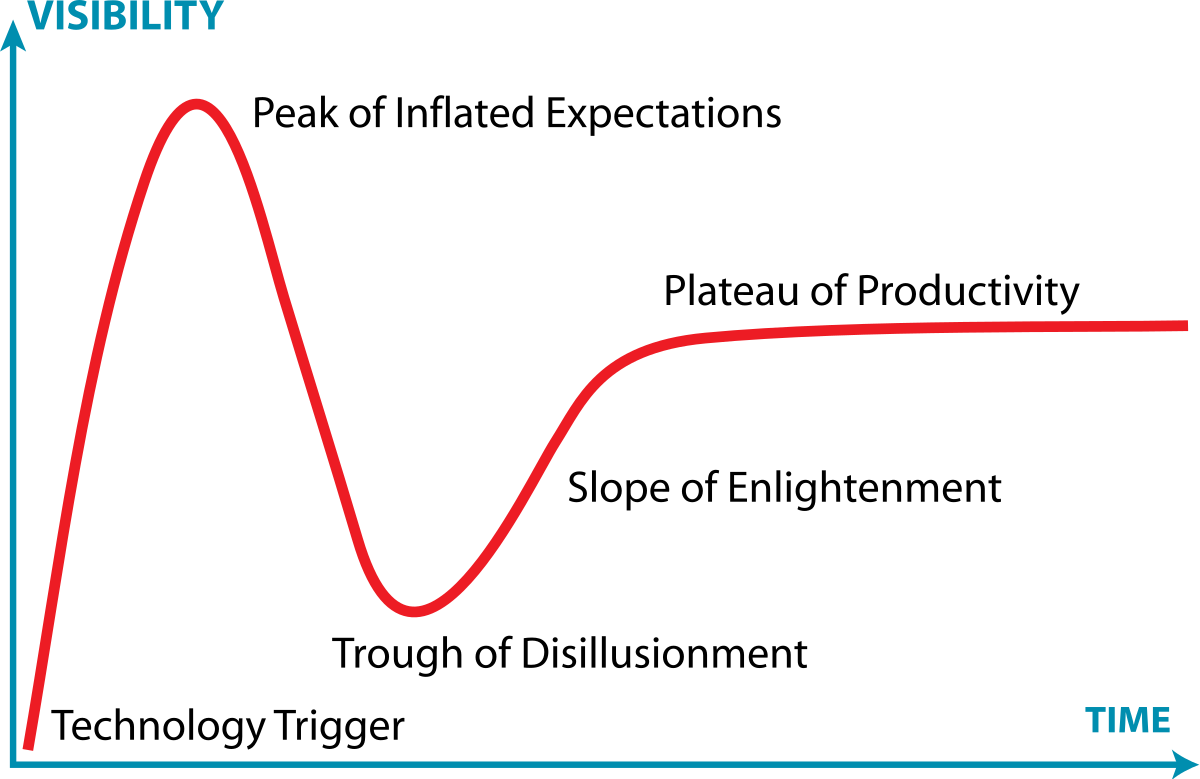What the hell is the Gartner Hype Cycle?
If you’re not in the IT world, you probably haven’t heard of the Gartner Hype Cycle.
It’s a very simple graphical model intended to explain the typical lifecycle that a new technology passes through from innovation to maturity.
The stages are evocatively named:
The peak of inflated expectations
The trough of disillusionment
The plateau of productivity

The basic premise is that everyone gets excited about a new technology like drones and believes they will change the world, then everyone gets sad because they realize the tech isn’t ready or there are real-world challenges, then after time, things mature, regulatory frameworks etc catch up, and the tech is now an accepted part of the landscape, delivering mainstream value.
Some technologies never make it through the full cycle: most commonly, they drop off the bottom of the trough. And technologies move through at different rates.
Although I’m bastardizing and distorting the concept (which is intended to map a landscape of different technologies by their maturity) I find this model to be very useful for understanding my relationship to individual products, like a fountain pen. If you’ve ever heard the phrase ‘honeymoon period’, well, that’s the peak of inflated expectations.
Here’s how it goes.
The first step is the Technology Trigger. For me, this is when a new model lands on my radar, often via Instagram or a newsletter. I feel the ‘ooh’. There’s something new or different here: the material, the design, an innovation. Recent examples include Schon’s Monoc nib or the Preppy Wa series — there’s something that makes me keep a tab open or put it on my list.
At this point, I often impulse purchase, although sometimes I talk myself down and realize that, for me or in general, this novelty has little real value to offer.
The next step is the Peak of Inflated Expectations. In a market sense, this is when everyone is talking about the pen on social networks — it may even be sold out. Remember the Primary Manipulation craze?
Personally, this is my honeymoon period. I’ve got the pen, I’ve inked it, and I use it constantly, admiring the smart design features and aesthetics that attracted me in the first place.
Just like on the hype cycle, this phase varies in length. Sometimes the novelty wears off in a week or two, and either I just get bored or I start to notice flaws.
This is where we get to the Trough of Disillusionment. In a market sense, this might be the backlash against Conid’s pricing increases, or Visconti’s nib quality.
In a personal sense, this is often where I sell a pen. It’s like the delayed version of buyer’s remorse: I’m bored and a little regretful, and when I pick up the pen all I can notice are the little irritations: sharp threads, mismatched patterns, slippery grips. I compare it to my other existing pens and I feel the new arrival adds little extra value. I worry about long-term durability.
If I give it some time, this is where we reach the Slope of Enlightenment. If a pen has survived this long, I start to mellow on both its good and bad points. The good no longer wows me, the bad no longer enrages me, and I start to see it as an overall enjoyable tool in my toolbox.
And this is where things always go one of two ways.
Either a pen makes it to the Plateau of Productivity, where I feel growing loyalty and fondness, or it slips off the slope: I realise I feel nothing, I am uninterested by the pen. All of the drama of excitement and irritation has evaporated and now it’s just a stick of plastic.
I sense this in others when I see BST threads saying ‘I just don’t reach for it’. This can be a curiously alienating experience when you look in the proverbial mirror and say ‘why was I so excited that I NEEDED to spend hundreds of pounds on it on the morning of release?’
But I would rather focus on the pens that endure the cycle: pens like the Montblanc 149 or Lamy 2000, where for me lust and novelty have long gone, and I’m left with absolute trust and admiration. They are my partners for the long haul.